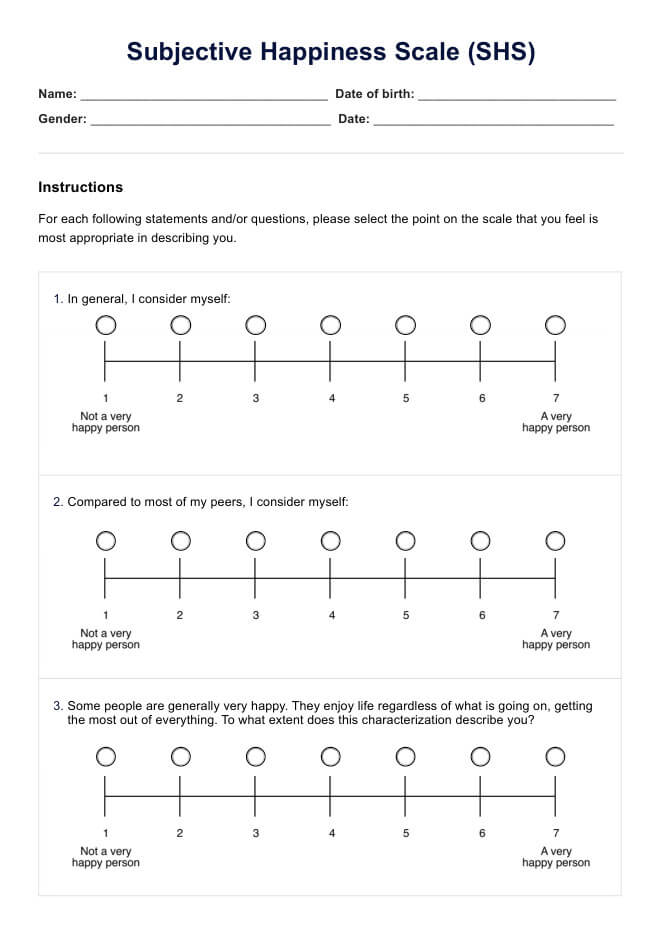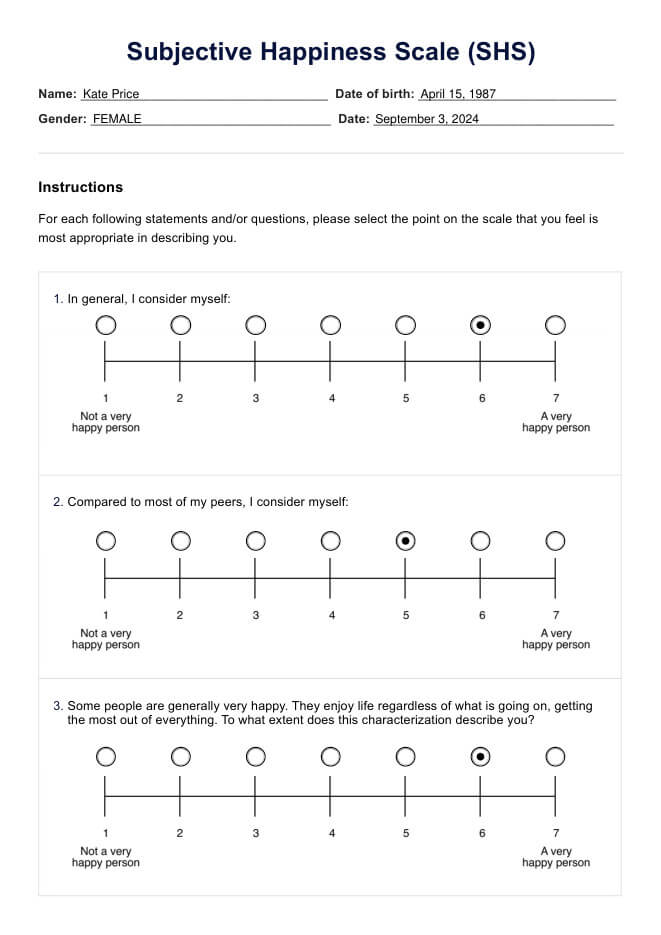Subjective Happiness Scale (SHS)
Assess subjective happiness with the Subjective Happiness Scale (SHS) PDF. Learn how to use it effectively to measure happiness levels.


What is the Subjective Happiness Scale (SHS)?
The Subjective Happiness Scale (SHS) is a widely recognized tool in the field of positive psychology, designed to measure an individual's overall happiness or subjective well-being. Developed by Sonja Lyubomirsky and Heidi Lepper (1999), the SHS is a brief, four-item questionnaire that evaluates a person's perception of their happiness in relation to others, as well as their subjective sense of global happiness. The scale is rooted in subjective well-being, which encompasses how individuals experience the quality of their lives, including emotional reactions and cognitive judgments.
One of the key strengths of the Subjective Happiness Scale is its focus on global subjective happiness. It provides a snapshot of how individuals perceive their happiness over time rather than just in the moment. This makes it a valuable tool in social indicators research, as it offers insights into the general psychological well-being of populations. The SHS is also noted for its construct validity, meaning it effectively measures what it intends to—happiness—across different cultural and demographic groups. The preliminary reliability of the SHS has been tested across various studies, consistently demonstrating its accuracy and dependability as a measure of happiness.
The scale includes items that characterize and describe both a "very happy person" and someone less happy, allowing respondents to place themselves on a continuum of happiness. This approach helps capture the nuances of positive emotions and positive affect, both critical components of life satisfaction and psychological well-being. By assessing these aspects, the SHS contributes to understanding how individuals enjoy life and experience positive emotions.
In practice, the SHS is often used in positive psychology interventions to enhance an individual's happiness and life satisfaction. It serves as a useful measure for gauging the effectiveness of these interventions and understanding how individuals can cultivate and maintain happiness in their lives. Through its focus on global subjective happiness, the SHS offers a comprehensive and reliable measure of a key aspect of human experience—our ability to enjoy life and experience positive emotions.
Subjective Happiness Scale (SHS) Template
Subjective Happiness Scale (SHS) Example
How to use our Subjective Happiness Scale template
This Subjective Happiness Scale template is designed to help healthcare professionals easily assess a patient's overall sense of happiness and well-being. Here is how you can use the SHS scale:
Access and use the scale template
You can find the Subjective Happiness Scale template within this guide, which is ready for immediate use. Simply download or print the template, and you'll have a reliable tool for assessing your patients' subjective well-being in just a few minutes.
Introduce the scale to the patient
When introducing the Subjective Happiness Scale to your patient, explain that this is a brief questionnaire designed to measure their overall sense of happiness. Emphasize that their responses will help you better understand their emotional state and guide your approach to their care.
Educate and instruct how the scale works
Educate the patient on how the scale works by explaining that it consists of four questions. Each question asks them to reflect on their happiness compared to others and their general feelings of happiness. Encourage honest and thoughtful responses for the most accurate results.
Score and interpret results
After the patient completes the scale, score their responses according to the provided guidelines. The total mean score will indicate their level of subjective happiness. Interpret the results within the context of the patient's overall well-being and use them to inform your clinical decisions.
Provide next steps
Based on the patient's score, discuss potential next steps. Consider suggesting positive psychology interventions or further psychological assessment if the score indicates lower happiness. For higher scores, reinforce the importance of maintaining their current level of well-being through continued self-care and support.
Scoring
The Subjective Happiness Scale is scored by averaging the responses to its four items, providing a final score that ranges from 1.0 to 7.0. To calculate this, each of the first three items is scored as answered, while the fourth item requires reverse coding—where a response of 7 is recorded as 1, 6 as 2, and so on. Once all responses are scored, the average of these values represents the individual's subjective happiness level.
A higher final score indicates greater subjective happiness, reflecting a stronger sense of overall well-being. Conversely, a lower score suggests less happiness, signaling potential areas where further psychological support may be beneficial. This straightforward scoring system allows healthcare professionals to quickly assess and interpret an individual's general happiness, providing valuable insights that can guide subsequent interventions or care strategies.
Next steps after using the scale
After administering the Subjective Happiness Scale, the next steps involve interpreting the results to inform further actions. If the scale indicates that a patient is a "very happy person," you might focus on maintaining this positive emotional state through continued support and encouragement. However, if the results show lower happiness levels, consider implementing positive psychology interventions to enhance well-being.
Incorporate findings from social indicators research to understand the broader context of your patient's happiness and how it compares to population norms. When discussing the results, focus on characterizing and describing the patient's emotional state, linking it to their overall psychological well-being.
Reference
Lyubomirsky, S., & Lepper, H. S. (1999). A measure of subjective happiness: Preliminary reliability and construct validation. Social Indicators Research, 46(2), 137–155. https://doi.org/10.1023/A:1006824100041
Commonly asked questions
The subjective level of happiness refers to an individual's personal perception and evaluation of their overall happiness and life satisfaction. It is a self-reported measure that captures how content and positive a person feels about their life.
Yes, the Subjective Happiness Scale has demonstrated strong reliability through various studies, including preliminary reliability tests. Its consistent performance across different populations underscores its effectiveness in measuring subjective well-being.
Yes, happiness is inherently subjective. It reflects an individual's feelings and assessments of their emotional state and life satisfaction. It varies from person to person based on personal experiences and perceptions.
Psychologists Sonja Lyubomirsky and Heidi Lepper created the Subjective Happiness Scale in 1999. They aimed to develop a simple, effective tool for assessing global subjective happiness.





















-template.jpg)


















































































